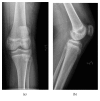Epiphyseal Primary Diffuse Large B-Cell Lymphoma of Bone
- PMID: 30598851
- PMCID: PMC6287168
- DOI: 10.1155/2018/4160925
Epiphyseal Primary Diffuse Large B-Cell Lymphoma of Bone
Abstract
Primary lymphoma of bone (PLB) confined to the epiphysis has only been described in four other patients. Due to the rarity of this entity, diagnosis has often been delayed, leading to mismanagement with adverse clinical consequences. We report a fifth case of primary epiphyseal lymphoma of bone located in the left distal medial femoral epiphysis of a 13-year-old boy. Radiographic and histologic features of PLB are discussed, along with a review of the literature and pitfalls of misdiagnosis. The patient initially presented with six months of progressive left knee pain with an associated loss of passive range of motion. Imaging revealed a mixed radiolucent lesion within the left distal medial femoral epiphysis with cortical breakthrough. A core biopsy was performed revealing a blue round cell tumor. Thanks to modern immunohistochemistry techniques, a diagnosis of primary lymphoma of bone was quickly made. The patient thus avoided further surgical intervention and received the appropriate treatment of chemotherapy, with subsequent rapid resolution of the lesion. This case highlights the necessity of including primary lymphoma of bone in all epiphyseal lesion differential diagnoses, especially in the pediatric patient population when aggressive radiographic features are present.
Figures










References
-
- Kitsoulis P., Vlychou M., Papoudou-Bai A., et al. Primary lymphomas of bone. Anticancer Reseach. 2006;26(1):325–337. - PubMed
-
- Hogendoorn P. C. W., Kluin P. M. Primary non-Hodgkin lymphoma of bone. In: Fletcher C. D. M., Bridge J. A., Hogendoorn P. C. W., Mertens F., editors. WHO Classification of Tumours of Soft Tissue and Bone. 4th 2013.
Publication types
Grants and funding
LinkOut - more resources
Full Text Sources

